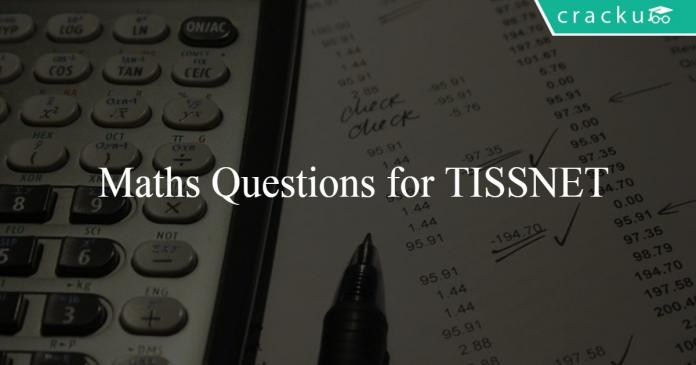Maths Questions for TISSNET PDF
Download important TISSNET Maths Questions PDF based on previously asked questions in TISSNET and other MBA exams. Practice Maths Questions and answers for TISSNET and other exams.
Download TISSNET Previous Year Papers
Question 1: How many pairs of positive integers m, n satisfy 1/m + 4/n = 1/12 , where n is an odd integer less than 60?
a) 6
b) 4
c) 7
d) 5
e) 3
Question 2: Let T be the set of integers {3,11,19,27,…451,459,467} and S be a subset of T such that the sum of no two elements of S is 470. The maximum possible number of elements in S is
a) 32
b) 28
c) 29
d) 30
Question 3: Suppose n is an integer such that the sum of digits on n is 2, and $10^{10} < n < 10^{11}$. The number of different values of n is
a) 11
b) 10
c) 9
d) 8
Question 4: If a/b = 1/3, b/c = 2, c/d = 1/2 , d/e = 3 and e/f = 1/4, then what is the value of abc/def ?
a) 3/8
b) 27/8
c) 3/4
d) 27/4
e) 1/4
Question 5: What are the values of x and y that satisfy both the equations?
$2^{0.7x} * 3^{-1.25y} = 8\sqrt{6}/27$
$4^{0.3x} * 9^{0.2y} = 8*81^{1/5}$
a) x = 2, y = 5
b) x = 2.5, y = 6
c) x =3, y = 5
d) x = 3,y = 4
e) x = 5,y = 2
Preparation tips for CAT – Beginners
Get 5 SNAP mock tests for Rs. 299/-
Download SNAP Previous Papers PDF
Question 6: If R = $(30^{65}-29^{65})/(30^{64}+29^{64})$ ,then
a) $0<R\leq0.1$
b) $0.1<R\leq0.5$
c) $0.5<R\leq1.0$
d) $R>1.0$
Question 7: If x = $(16^3 + 17^3+ 18^3+ 19^3 )$, then x divided by 70 leaves a remainder of
a) 0
b) 1
c) 69
d) 35
Question 8: Let $n!=1*2*3* …*n$ for integer $n \geq 1$.
If $p = 1!+(2*2!)+(3*3!)+… +(10*10!)$, then $p+2$ when divided by 11! leaves a remainder of
a) 10
b) 0
c) 7
d) 1
Question 9: Let $x = \sqrt{4+\sqrt{4-\sqrt{4+\sqrt{4- \ to \ infinity}}}}$. Then x equals
a) 3
b) $(\sqrt{13} – 1)/2$
c) $(\sqrt{13} + 1)/2$
d) $\sqrt{13}$
Question 10: Let N = 1421 * 1423 * 1425. What is the remainder when N is divided by 12?
a) 0
b) 9
c) 3
d) 6
Answers & Solutions:
1) Answer (E)
1/m + 4/n = 1/12
So, 1/m = 1/12 – 4/n
So, m = 12n/(n-48)
Since m is positive, n should be greater than 48
Also, since n is an odd number, it can take only 49, 51, 53, 55, 57 and 59
If n = 49, 51, 57 then m is an integer, else it is not an integer
So, there are 3 pairs of values for which the equation is satisfied
2) Answer (D)
No. of terms in series T , 3+(n-1)*8 = 467 i.e. n=59.
Now S will have atleast have of 59 terms i.e 29 .
Also the sum of 29th term and 30th term is less than 470.
Hence, maximum possible elements in S is 30.
3) Answer (A)
The sum of digits should be 2. The possibilities are 1000000001,1000000010,10000000100,..these 10 cases . Also additional 1 case where 20000000000. Hence option A .
4) Answer (A)
a/d = a/b * b/c * c/d = 1/3 * 2 * 1/2 = 1/3
Similarly, b/e and c/f are 3 and 3/8 respectively.
b/e = b/c*c/d*d/e = 3
c/f = c/d*d/e*e/f = 3/8
=> Value of abc/def = 1/3 * 3 * 3/8 = 3/8
5) Answer (E)
$2^{0.7x} * 3^{-1.25y} = 8\sqrt{6}/27$ => $2^{0.7x} * 3^{-1.25y}$ = $2^{3.5} * 3^{-2.5}$
=> 0.7x = 3.5 => x = 5
=> -1.25y = -2.5 => y = 2
$4^{0.3x} * 9^{0.2y} = 8*81^{1/5}$ => $2^{0.6x} * 3^{0.4y}$ = $2^3 * 3^{0.8}$
=> 0.6x = 3 => x = 5
=> 0.4y = 0.8 => y = 2
=> (5,2) is the solution.
6) Answer (D)
$\frac{(30^{65}-29^{65})}{(30^{64}+29^{64})} = ((30-29)*\frac{(30^{64}+30^{63}*29+….+29^{64})}{(30^{64}+29^{64})}$ , which is greater than 1 . Hence option D.
7) Answer (A)
We know that x = $16^3 + 17^3 + 18^3 + 19^3 = (16^3 + 19^3) + (17^3 + 18^3)$
= $(16 + 19)(16^2 – 16 * 19 + 19^2) + (17 + 18)(17^2 – 17 * 18 + 18^2)$ = 35 × odd + 35 × odd = 35 × even = 35 × (2k)
=> x = 70k
=> Remainder when divided by 70 is 0.
8) Answer (D)
According to given condiiton we have p = (1 × 1!) + (2 × 2!) + (3 × 3!) + (4 × 4!) + … + (10 × 10!) . So n × n! = [(n + 1) – 1] × n! = (n + 1)! – n!. So equation becomes p = 2! – 1! + 3! – 2! + 4! – 3! + 5! – 4! +… + 11! – 10!. So p = 11! – 1! = 11! – 1. p + 2 = 11! + 1 .So when it is divided by 11! gives a remainder of 1. Hence, option 4.
9) Answer (C)
$x = \sqrt{4+\sqrt{4-\sqrt{4+\sqrt{4- \ to \ infinity}}}}$
=> $x = \sqrt{4+\sqrt{4-x}}$
=> $x^2 = 4 + \sqrt{4-x}$
=>$x^4 + 16 – 8x^2 = 4 – x$
=> $x^4 – 8x^2 + x +12 = 0$
On substituting options, we can see that option C satisfies the equation.
10) Answer (C)
The numbers 1421, 1423 and 1425 when divided by 12 give remainder 5, 7 and 9 respectively.
5*7*9 mod 12 = 11 * 9 mod 12 = 99 mod 12 = 3
TISSNET Solved Previous papers
We hope this Maths Questions PDF for TISSNET with Solutions will be helpful to you.





![CAT Averages Questions PDF [Important Questions] CAT AVERAGES Questions PDF](https://cracku.in/blog/wp-content/uploads/2022/07/CAT-AVERAGES-Questions-PDF-218x150.png)